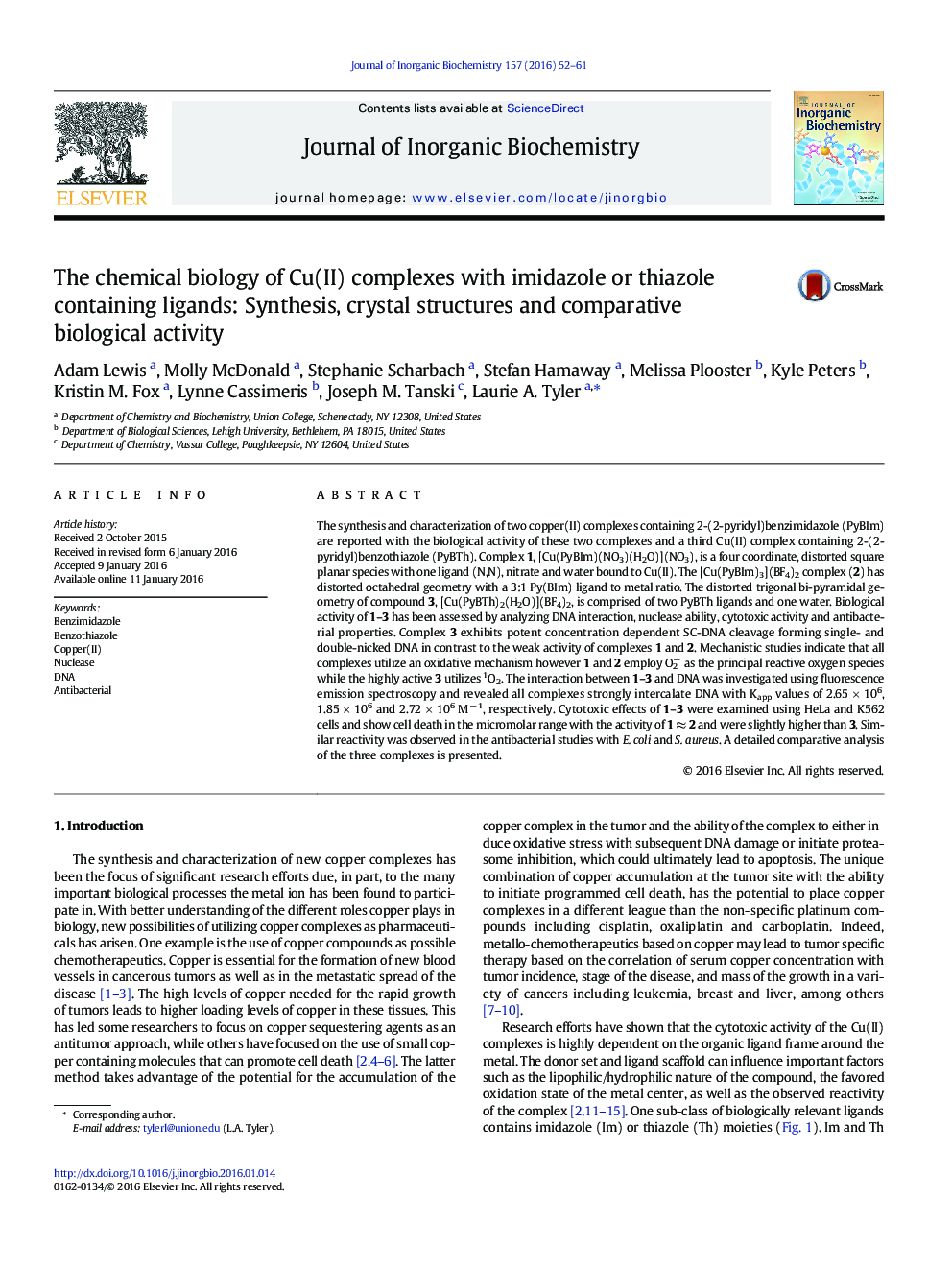| کد مقاله | کد نشریه | سال انتشار | مقاله انگلیسی | نسخه تمام متن |
|---|---|---|---|---|
| 1316892 | 1499430 | 2016 | 10 صفحه PDF | دانلود رایگان |

• CuThiazole (CuTh) species act as potent nucleases at low conc. and short incubation times.
• CuImidazole (CuIm) complexes exhibit much lower nuclease activity.
• Both CuIm and CuTh complexes utilize an oxidative mechanism.
• O2− is key in the mechanism for CuIm species while 1O2 is utilized by CuTh.
• CuIm complexes exhibit greater antibacterial properties.
The synthesis and characterization of two copper(II) complexes containing 2-(2-pyridyl)benzimidazole (PyBIm) are reported with the biological activity of these two complexes and a third Cu(II) complex containing 2-(2-pyridyl)benzothiazole (PyBTh). Complex 1, [Cu(PyBIm)(NO3)(H2O)](NO3), is a four coordinate, distorted square planar species with one ligand (N,N), nitrate and water bound to Cu(II). The [Cu(PyBIm)3](BF4)2 complex (2) has distorted octahedral geometry with a 3:1 Py(BIm) ligand to metal ratio. The distorted trigonal bi-pyramidal geometry of compound 3, [Cu(PyBTh)2(H2O)](BF4)2, is comprised of two PyBTh ligands and one water. Biological activity of 1–3 has been assessed by analyzing DNA interaction, nuclease ability, cytotoxic activity and antibacterial properties. Complex 3 exhibits potent concentration dependent SC-DNA cleavage forming single- and double-nicked DNA in contrast to the weak activity of complexes 1 and 2. Mechanistic studies indicate that all complexes utilize an oxidative mechanism however 1 and 2 employ O2− as the principal reactive oxygen species while the highly active 3 utilizes 1O2. The interaction between 1–3 and DNA was investigated using fluorescence emission spectroscopy and revealed all complexes strongly intercalate DNA with Kapp values of 2.65 × 106, 1.85 × 106 and 2.72 × 106 M− 1, respectively. Cytotoxic effects of 1–3 were examined using HeLa and K562 cells and show cell death in the micromolar range with the activity of 1 ≈ 2 and were slightly higher than 3. Similar reactivity was observed in the antibacterial studies with E. coli and S. aureus. A detailed comparative analysis of the three complexes is presented.
Cu(II) complexes containing a benzimidazole (PyBIm) or benzothiazole (PyBTh) within the ligand are reported. The PyBIm complexes were weak nucleases and relied on O2− as the principal reactive oxygen species. The PyBTh compound exhibited strong nuclease activity and relied on 1O2. In contrast, compounds containing PyBIm exhibited greater cell toxicity.Figure optionsDownload as PowerPoint slide
Journal: Journal of Inorganic Biochemistry - Volume 157, April 2016, Pages 52–61